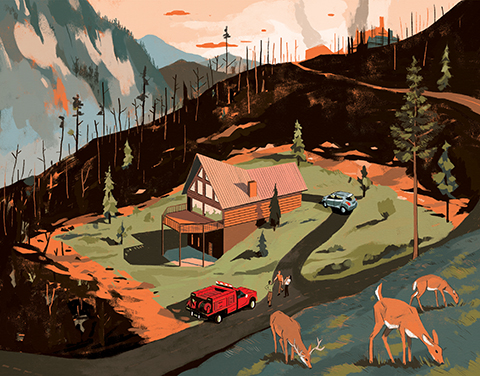A safe and resilient, natural and built environment
Metro Vision helps lay a foundation for regional cooperation to safeguard the region's natural resources for all residents and to ensure access to those spaces remain inclusive to all residents regardless of cultural identities, genders and socioeconomic levels. Preservation includes provisions for clean water and air and lower greenhouse gas emissions. Protecting the lands also means creating strategic plans to mitigate injuries and loss of life and trauma disaster response and recovery efforts.

Desired outcomes
The region has clean water and air, and lower greenhouse gas emissions.
The region meets or exceeds applicable federal, state, and local requirements and regional targets for air and water quality.
The region values, protects and connects people to its diverse natural resource areas, open space, parks and trails.
The region’s protection and restoration of its diverse natural resource areas—its mountain backdrop, unique prairie landscapes, extensive riparian corridors and other open space areas, parks and trails—is essential as the region continues to grow. Access to these areas provides the opportunity to participate in a variety of recreational pursuits that support physical and mental health and wellness.
The region’s working agricultural lands and activities contribute to a strong regional food system.
Working agricultural lands are essential to the region’s heritage, health and economic and cultural diversity. Livestock feeding and production, growing feed and forage crops for livestock, food production, or greenhouse and nursery crops, agricultural lands and operations of all sizes create jobs in the region, support economic vitality and promote healthier communities by bringing people closer to their food source.
The risks and effects of natural and human-created hazards are reduced.
Hazard mitigation planning reduces injuries and loss of life, trauma, and damage to property, equipment and infrastructure. Communities are more resilient when planning also accounts for disaster response and recovery.
Strategies to address public safety and natural resource preservation
The Interagency Council on Homeless Encampments is a collaborative effort to build trust and dialogue between community members, local law enforcement and groups that manage public lands. The work of the council focuses on the intersection of natural resource preservation and public health and safety in the unique context of our region’s mountain communities. Outcomes of the program have progressed the conversation around best practices for outreach and education.
Performance measures
Performance measures are critically important in monitoring the region’s progress toward Metro Vision themes and outcomes. They are used to obtain regular measurement of outcomes and results. They also generate reliable data to help local governments and partners evaluate policies, programs and initiatives. As part of its reporting on plan progress toward an efficient and predictable development pattern, DRCOG will use the metrics outlined on the Metro Vision performance measures page.
| Measure | Where are we today? (baseline) | Baseline year | Where do we want to be? (target) | Target year |
|---|---|---|---|---|
| Surface transportation-related greenhouse gas emissions per capita | 26.8 pounds per capita | 2010 | 60% decrease from 2010 | 2040 |
| Protected open space | 1,724 square miles | 2014 | 1,980 square miles | 2040 |
| Share of the region’s housing in high risk areas | 3.7% | 2020 | Less than 3.1% | 2040 |
| Share of the region’s employment in high risk areas | 1.8% | 2020 | Less than 1.6% | 2040 |
